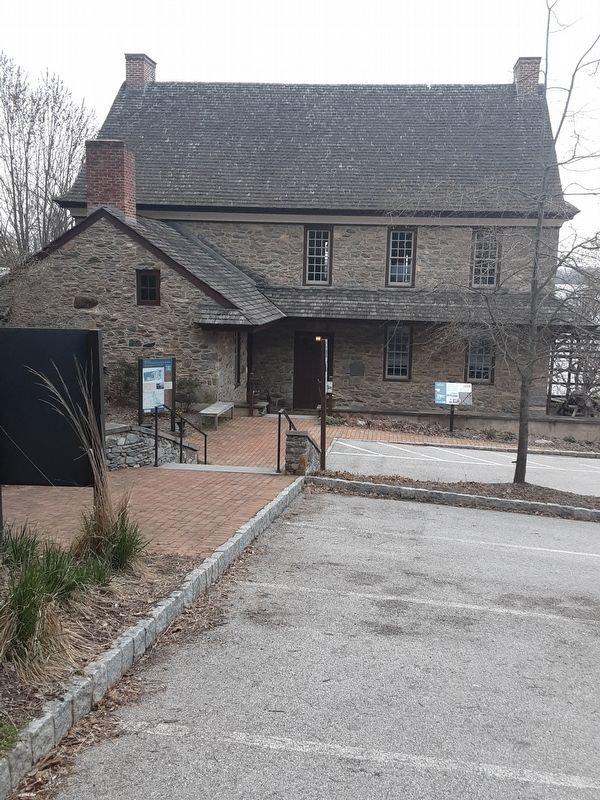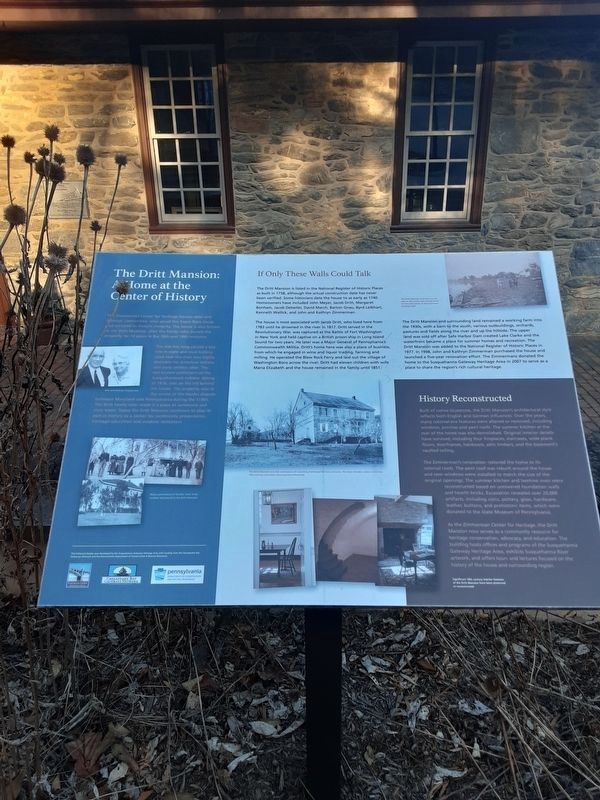Lower Windsor Township in Long Level in York County, Pennsylvania — The American Northeast (Mid-Atlantic)
The Dritt Mansion: A Home at the Center of History
Inscription.
The Zimmerman Center for Heritage honors John and
Kathryn Zimmerman, who saved this home from decay
and restored its historic integrity. The house is also known as the Dritt Mansion, after the family who owned the property for 70 years in the 18th and 19th centuries.
This site has long played a key role in state and local history. Land near the river was highly desirable for American Indians and early settlers alike. The last known settlement of the Susquehannock Indians, dating to 1676, was on the hill behind the house. The property was at the center of the border dispute between Maryland and Pennsylvania during the 1730's. The Dritt family later made it a place of commerce and river trade. Today the Dritt Mansion continues to play its part in history as a center for community preservation, heritage education and outdoor recreation.
[caption:]
Many generations of families have lived, worked and played at the Dritt Mansion.
If Only These Walls Could Talk
The Dritt Mansion is listed in the National Register of Historic Places as built in 1758, although the actual construction date has never been verified. Some historians date the house to as early as 1740. Homeowners have included John Meyer, Jacob Dritt, Margaret Bonham, Jacob Detwiler, David March, Barton Gnau, Byrd Leibhart, Kenneth Wallick, and John and Kathryn Zimmerman.
The house is most associated with Jacob Dritt, who lived here from 1783 until he drowned in the river in 1817. Dritt served in the Revolutionary War, was captured at the Battle of Fort Washington in New York and held captive on a British prison ship in Long Island Sound for two years. He later was a Major General of Pennsylvania's Commonwealth Militia. Dritt's home here was also a place of business, from which he engaged in wine and liquor trading, farming and milling. He operated the Blew Rock Ferry and laid out the village of Washington Boro across the river. Dritt had eleven children with wife Maria Elizabeth and the house remained in the family until 1851.
The Dritt Mansion and surrounding land remained a working farm into the 1930s, with a barn to the south, various outbuildings, orchards, pastures and fields along the river and up the hillside. The upper land was sold off after Safe Harbor Dam created Lake Clarke and the waterfront became a place for summer homes and recreation. The Dritt Mansion was added to the National Register of Historic Places in 1977. In 1998, John and Kathryn Zimmerman purchased the house and launched a five-year renovation effort. The Zimmermans donated the home to the Susquehanna Gateway Heritage Area in 2007 to serve as a place to share

Photographed By Carl Gordon Moore Jr., April 9, 2021
2. The Dritt Mansion: A Home at the Center of History Marker
At far left is back of "Native Lands Trailhead" plaque. From left to right in background:
"Welcome to the Zimmerman Center for Heritage" plaque (sent to hmdb.org as accompaniment to next plaque),
"The John & Kathryn Zimmerman Center for Heritage" plaque (mounted directly on building),
this ("The Dritt Mansion: A Home at the Center of History") plaque.
"Welcome to the Zimmerman Center for Heritage" plaque (sent to hmdb.org as accompaniment to next plaque),
"The John & Kathryn Zimmerman Center for Heritage" plaque (mounted directly on building),
this ("The Dritt Mansion: A Home at the Center of History") plaque.
[caption:]
The Dritt Mansion was the centerplece of a working farmstead for two centuries. The bare hillsides visible in this late 19th century view have since became reforested.
[caption:]
The Dritt Mansion and barn can be seen in the center-right background of this early photo of the riverfront looking south.
History Reconstructed
Built of native bluestone, the Dritt Mansion's architectural style reflects both English and German influences. Over the years, many colonial-era features were altered or removed, including windows, porches and pent roofs. The summer kitchen at the rear of the home was also demolished. Original interior details have survived, including four fireplaces, staircases, wide plank floors, doorframes, hardware, attic timbers, and the basement's vaulted ceiling.
The Zimmerman's renovation restored the home to its colonial roots. The pent roof was rebuilt around the house and new windows were installed to match the size of the original openings. The summer kitchen and beehive oven were reconstructed based on uncovered foundation walls and hearth bricks. Excavation revealed over 20,000 artifacts, including coins, pottery, glass, hardware, leather, buttons, and prehistoric items, which were donated to the State Museum of Pennsylvania.
As the Zimmerman Center for Heritage, the Dritt Mansion now serves as a community resource for heritage conservation, advocacy, and education. The building hosts offices and programs of the Susquehanna Gateway Heritage Area, exhibits Susquehanna River artwork, and offers tours and lectures focused on the history of the house and surrounding region.
Significant 18th century interior features of the Dritt Mansion have been preserved or reconstructed.
This historical display was developed by the Susquehanna Gateway Heritage Area with funding from the Chesapeake Bay Gateways Network and the Pennsylvania Department of Conservation & Natural Resources.
Erected by Zimmerman Center for Heritage.
Topics and series. This historical marker is listed in these topic lists: Colonial Era • Settlements & Settlers • War, US Revolutionary. In addition, it is included in the National Register of Historic Places series list. A significant historical year for this entry is 1758.
Location. 39° 58.658′ N, 76° 29.781′ W. Marker is in Long Level, Pennsylvania, in York County. It is in Lower Windsor Township. Marker can be reached from Long Level Road (Pennsylvania Route 624), on the left when traveling north. Touch for map. Marker is at or near this postal address: 1706 Long Level Road, Wrightsville PA 17368, United States of America. Touch for directions.
Other nearby markers. At least 8 other markers are within walking distance of this marker. Native Lands Trailhead (a few steps from this marker); The John & Kathryn Zimmerman Center for Heritage (a few steps from this marker); Captain Thomas Cresap (a few steps from this marker); Thomas Cresap and the Border War (within shouting distance of this marker); Gateway to the Bay (within shouting distance of this marker); Latrobe's Survey of the Susquehanna (within shouting distance of this marker); Cresap's Fort (approx. 0.3 miles away); Susquehanna and Tidewater Canal (approx. 0.9 miles away). Touch for a list and map of all markers in Long Level.
Credits. This page was last revised on June 7, 2023. It was originally submitted on April 7, 2021, by Carl Gordon Moore Jr. of North East, Maryland. This page has been viewed 624 times since then and 82 times this year. Last updated on June 4, 2023, by Annette Fillmore of York, Pennsylvania. Photos: 1. submitted on April 7, 2021, by Carl Gordon Moore Jr. of North East, Maryland. 2. submitted on April 10, 2021, by Carl Gordon Moore Jr. of North East, Maryland. • Bill Pfingsten was the editor who published this page.
